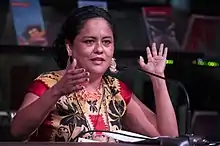Natalia Toledo
Natalia Toledo Paz (born 1968) is a Mexican poet who writes in Spanish and Zapotec. Her work helped to revive interest in the Zapotec language.[1] Ida Kozlowska-Day states that Toledo is "one of the most recognized contemporary poets in the native languages of Mexico."[2]
Natalia Toledo Paz | |
|---|---|
 | |
| Born | Juchitán de Zaragoza, Oaxaca, Mexico |
| Language | Zapotec, Spanish |
| Genre | Poetry |
| Subject | Women, environment, indigenous cultures |
| Notable works | Cuento del Conejo y el Coyote/ Didxaguca' sti' Lexu ne Gueu' (2008), Black Flower and Other Zapotec Poems (2015) |
| Spouse | |
| Children | 2 |
Early life and education
Toledo Paz was born in Juchitán de Zaragoza, Oaxaca.[3] She is daughter of the painter Francisco Toledo[4] and sister of Dr Lakra. Until she was seven and moved to Mexico City, Toledo Paz lived in a community where Zapotec was the main language spoken.[2] Toledo Paz has been writing since she was young.[1] Toledo Paz studied in Casa de la Cultura de Juchitán and Sociedad General de Escritores de México (the General Society of Writers of Mexico, SOGEM).[3]
Career
Toledo Paz's writing has been concerned with women and their relationship to the environment.[5] Her writing, along with other writers' use of the Zapotec language in their work, has helped boost demand in Mexico to make indigenous cultures more visible.[6] Toledo Paz enjoys using the Zapotec language because she feels that it has "a great aesthetic sensibility for creating images and beauty."[2]
Toledo Paz has also collaborated with her father, Francisco, to create children's stories, such as Light Foot/Pies ligeros (2007).[7] Toledo Paz has been a fellow of Fondo Nacional para la Cultura y las Artes (the National Fund for Culture and for the Arts, FONCA) (1994–1995; 2001–2002), and Fondo Estatal para la Cultura y las Artes de Oaxaca (the Fund for Culture and for the Arts of Oaxaca, FOESCA) (1995–1996).[3]
She is the president of Patronato de la Casa de la Cultura de Juchitán (Fund of the House of Culture of Juchitán).
Selected works
- Poetry
- Paraíso de fisuras (1990), junto con Rocío González, Consejo Estatal para la Cultura y las Artes de Oaxaca.
- Ca guna gu bidxa, ca guna guiiba' risaca (Mujeres del sol, mujeres de oro, 2002), Instituto Oaxaqueño de las Culturas.
- Guie' yaase' (Olivo negro, 2004), CONACULTA.
- Xtaga be'ñe' (Flor de pantano, 2004), Instituto Oaxaqueño de las Culturas.
- Guendaguti ñee sisi (La muerte pies ligeros, 2005), Fondo de Cultura Económica.
- Anthologies
- Demián Flores Cortés (1993), Palimpsesto, Ediciones Bi'cu'.
- Aurora Mayra Saavedra (1996) Las divinas mutantes, UNAM.
- Antología de poetas de Tierra Adentro (1997), TELAM Nava.
- Varios Autores (1997), Historia de Arte de Oaxaca, tomo lll, Gobierno del Estado de Oaxaca.
- Miguel Flores (1998), Toledo: la línea metafórica, Ediciones Oro de la Noche/FONCA.
- Víctor de la Cruz (1999), Guie' sti' diidxazá, La flor de la palabra, UNAM.
- Verónika Bennholdt-Thomsen (2000), Juchitán-Mexikos stad der fra un, Frederking & Thaler, Germany.
- Memoria del XII Festival Internacional de Poesía de Medellín (2002), Colombia.
- Mónica de la Torre, Michael Wiegers (2002), Reversible Monuments: Contemporary Mexican Poetry, Copper Canyon Press, USA.
- Carlos Montemayor (2003), La voz profunda, antología de literatura mexicana en lenguas indígenas, Joaquín Mortiz.
- Carlos Montemayor y Donald Frischmann (2006), Words of the True Peoples. Anthology of Mexican Indigenous-Language Writers, University of Texas Press.
Prizes
- Premio Nezahualcóyotl de Literatura, 2004.[3]
References
- "Entregan premio Nezahualcóyotl a la poeta Natalia Toledo Paz". Letralia: Teirra de Letras (in Spanish) (118). 22 November 2004. ISSN 1856-7983. Retrieved 15 December 2015.
- Kozlowska-Day, Ida (2013). "The Ecological Dimension of Natalia Toledo Paz's Poetry". In Lopez, Francisca (ed.). Global Issues in Contemporary Hispanic Women's Writing: Shaping Gender, the Environment, and Politics. New York: Routledge. pp. 140–142. ISBN 9780415626941.
- "Ceremonia de premaicion a la escritora zapoteca Natalia Toledo". Premio Nezahualcoyoti de Literaturea 2004 (in Spanish). November 2004. Archived from the original on 11 November 2004. Retrieved 15 December 2015.
- Wadham, Tim (March 2008). "Light Foot/Pies ligeros". School Library Journal. 54 (3): 192. Retrieved 15 December 2015.
- Rosario, Mari Pino del (2014). "Global Issues in Contemporary Hispanic Women's Writing: Shaping Gender, the Environment, and Politics". Hispania (1): 154–155. doi:10.1353/hpn.2014.0006. S2CID 143936518.
- Klahn, Norma (2011). "El Indigenismo desde la Indigeneidad". Nuevo Texto Critico (in Spanish). 24 (1): 165–186. doi:10.1353/ntc.2011.0020. S2CID 161253274.
- Glantz, Shelley (2008). "Light Foot". Library Media Connection. 26 (4): 89. Retrieved 15 December 2015.
External links
- Interview
- Poetry on-line
- Dos poemas de Natalia Toledo La Jornada Ojarasca 47, March 2001.
- Tres poetas: Natalia Toledo, Víctor Manuel Pazarín y Rodolfo Alonso La Jornada Semanal, Núm. 378, 2 June 2002.